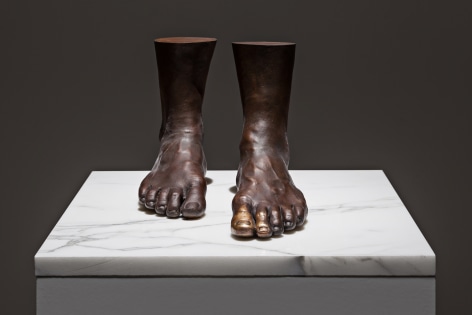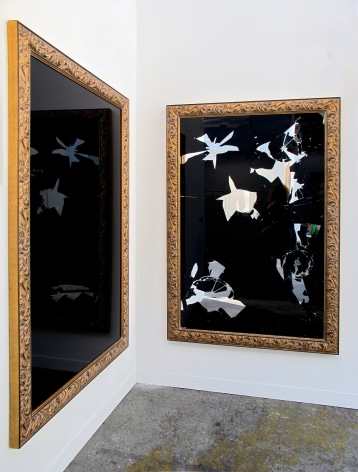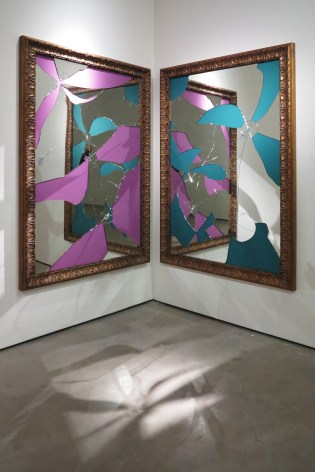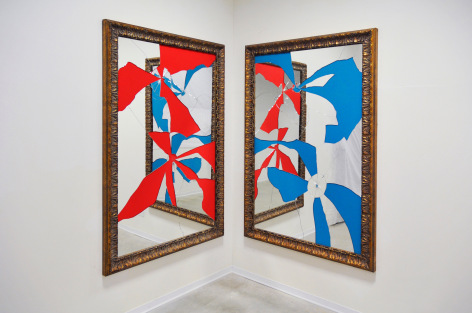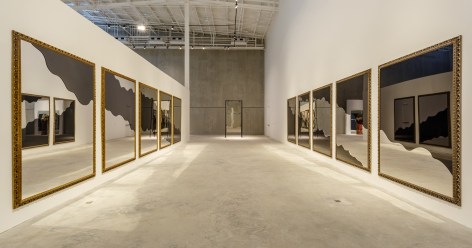
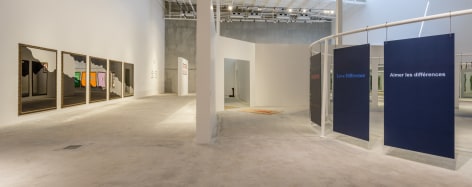
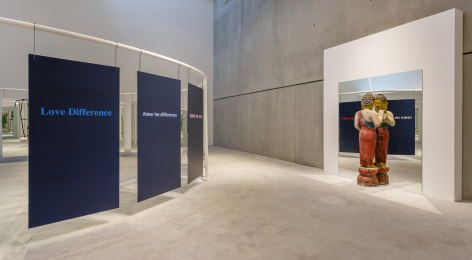
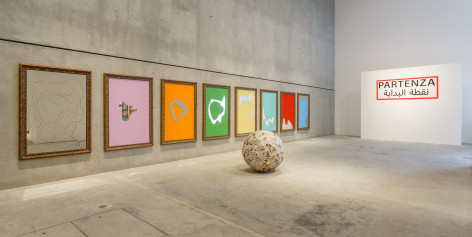
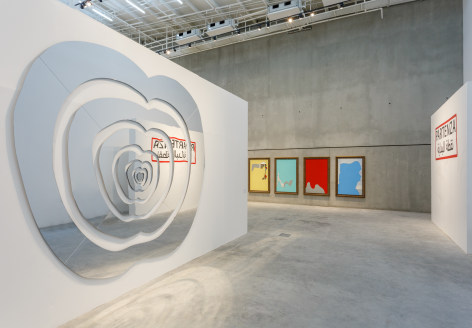
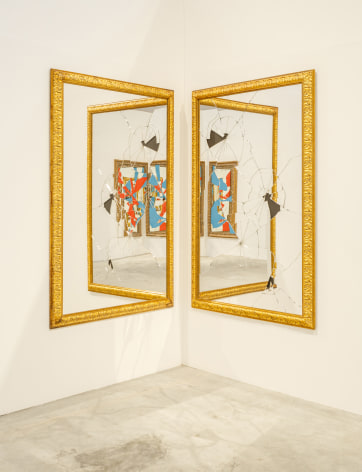
Two Less One, 2009
Gilded wood, mirror
2 elements, 180 x 120 cm each
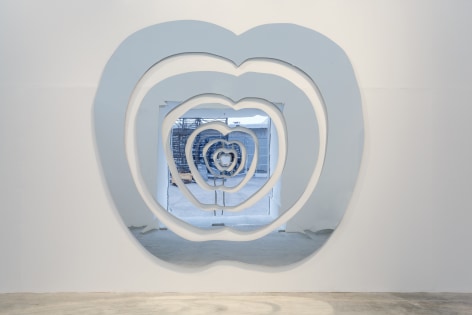
The Apple of Concord, 2007
Plexiglass
290 x 326 x 2 cm
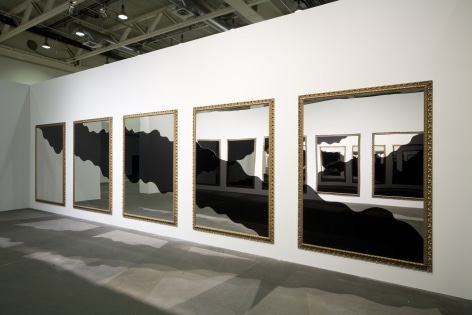
Black and Light Flux DARK, 2008
Black and silver mirror, wood
5 elements: 245 x 180 cm each
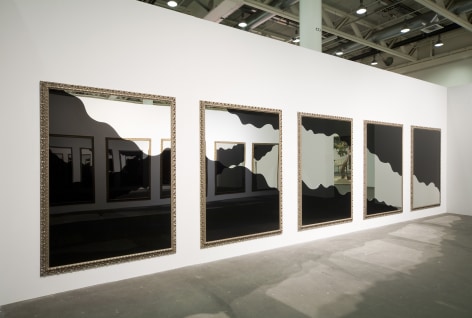
Black and Light Flux WHITE, 2008
Black and silver mirror, wood
5 elements: 245 x 180 cm each
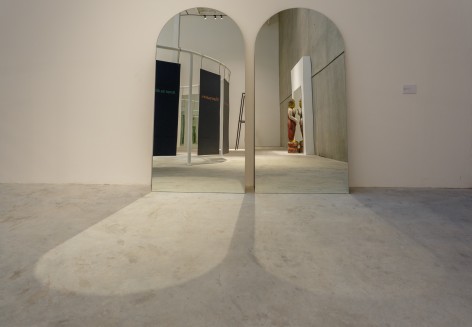
Il tempo del gludizio: Embraico (The Time of Judgement: Judaism), 2009-2011
2 mirrors
210 x 100 cm each
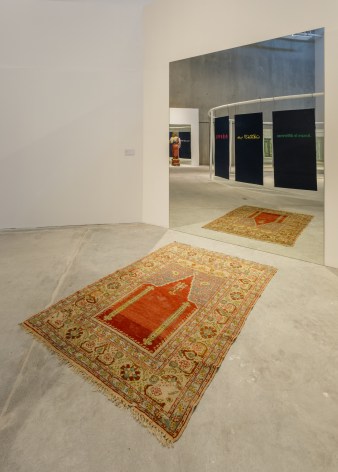
Il tempo del giudizio: Islamico (The Time of Judgement: Islam), 2009-2011
Mirror, prayer mat
Mirror: 250 x 200 cm; Prayer mat: 130 x 196 cm

Il giro del mondo, 1976
Vinyl stickers letters
Site specific dimensions
Artwork n°40 from the yellow book ‘Cento mostre nel mese di ottobre’, Turin 1976
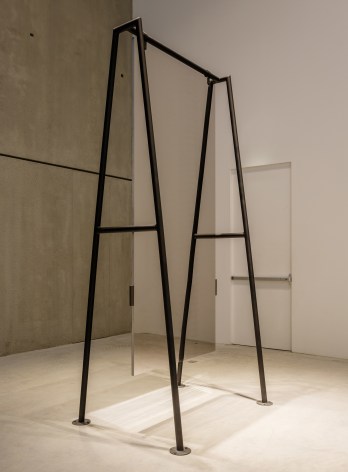
L'altalena, 1976
Mirroring steel, Iron
310 x 120 cm (mirroring steel: 260 x 120 cm)
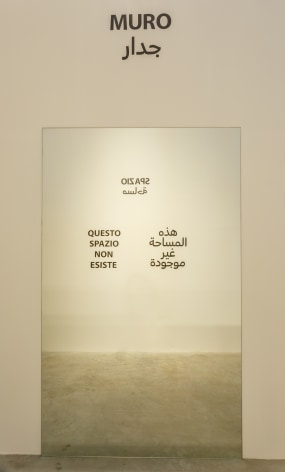
Questo spazio non esiste (The space does not exhisit), 1976
Mirror, vinyl adhesive letters
Site specific dimensions
Artwork n°40 from the yellow book ‘Cento mostre nel mese di ottobre’, Turin 1976
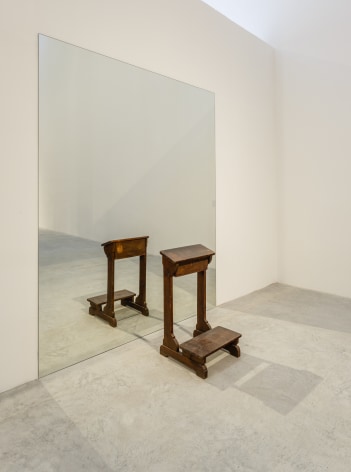
Inginocchiatoio, 2008
Mirror, wood
Mirror: 250 x 200 cm; kneeling-stool: 99 x 50 x 49 cm
Il bacio al plede, 1976
Brass, marble
28 x 50 x 50 cm
Color and Light, 2014
Juta, mirror, gilded wood
8 elements: 180 x 120 cm each
Two Less One Black, 2011
Black and silver mirror, gilded wood
2 elements, 180 x 120 cm each
Two Less One colored, 2014
Mirror, gilded wood
2 elements, 180 x 120 cm each
Two Less One Colored, 2015
Mirror, gilded wood
2 elements, 180 x 120 cm
Leila Heller Gallery invites Galleria Continua to organize a solo show of Michelangelo Pistoletto in an exclusive exhibition from March 14th to April 25th at Alserkal Avenue. Beginning with explorations of portraiture in his early career, Pistoletto, also known as the founder of the Arte Povera movement, employs a conception of the space of art as the space of action. For nearly half a century, Michelangelo Pistoletto has merged art and its environment through performance, sculptural installation and, most famously, his iconic mirror paintings. Comprised of photo-silkscreened images on steel, these signature works were developed in 1962 and represent the artist’s interest in not only conceptualism and figuration, but also in an intrinsically socially engaged politics of viewing which is, for Pistoletto, the purpose and potential of artistic practice.
Central to the structural and aesthetic conceit of the mirror paintings is the inclusion of the spectator as a form of dialogical exchange, each as much experiential as environmental; the artist uses the concept and phenomenon of reflection as a means to demand that the viewer is also called into the position of participant in the contingent experience of the work of art. This emphasis on contingency, participation, and experience—from the very inception of the mirror paintings in the early 1960s to the present day—can be seen as intrinsically related to Pistoletto’s interest in performance, beginning with solo works and developing into large collaborative installation ‘interventions’, otherwise understood as ‘happenings’. As the artist suggested in 1969, “The mirror paintings could not live without an audience.… The step from mirror paintings to theater—seems simply natural…It is less a matter of involving the audience, of letting it participate, as to act on its freedom and on its imagination, to trigger similar liberation mechanisms in people.”
Art as an act of intervention, liberation, and social exchange is nowhere more evident than in Pistoletto’s circular performative mirror installation Suspended Perimeter—Love Difference (1975-2011). As the artist wrote in 2002, in his Love Difference Manifesto, “Politics and the economy need to be inspired by a new way of thinking. The formative space for this thinking is the creative laboratory for socially-engaged art. Love Difference is a movement arising out of this laboratory.” Written four years after Pistoletto’s founding of Cittadellarte, a collaborative creative project space in his native Biella, Italy, this manifesto, and attendant work, are exponents of the artist’s desire to propose new inhabited spatial possibilities— unmooring the spectator’s passive experience—that “through creative engagement… work towards responsible social transformation.”
Also included in this exhibition, Pistoletto’s Black and Light Flux series from 2008 render the artist’s mirrors in their ultimate role as an image of the world, both of humans and society, and even of transcendental space. “It seems clear to me that the space in which this reflection takes place is neither limited nor exclusively individual, but is the cosmic space of totality and therefore of everyone.” Breaking the mirrors is equivalent for the artist to altering the prolongation of space and time, that is, of reality. In these works, the alternation between light and darkness is perfectly balanced. As in chaos theory, the apparent disorder is actually organized according to a hidden, more creative, order.
